How to Make the Most of Your Accounts in the Age of PPC Automation
by Aden Andrus • July 22, 2019
In the early days of paid search advertising, managing your account felt a lot like taking care of a toddler. It took constant supervision to keep things under control and headed in the right direction. Take your eyes off of things for too long and you’d quickly end up with a real mess on your hands.
Thankfully, paid search has grown up quite a bit since then.
These days, your pay-per-click (PPC) account needs a lot less hand-holding. Most PPC platforms offer a wide variety of automated options to help you get the results you want. In addition, advertisers have created countless scripts (here are just a few) that can pause your ads, adjust bid parameters or do almost anything you can think of in your account…all without your direct involvement.
But, like many parents dealing with their kids growing up, all of this PPC automation may leave you wondering, What’s my role now? Does my PPC account even need me anymore?

Fortunately, contrary to what your teenage kids might tell you, the answer is an unequivocal “yes!” While PPC now needs less day-to-day management than before, there’s a lot more competition out there, which means your accounts need more creativity, direction and guidance than ever.
So, now that PPC has matured, let’s take a look at a few ways that you can take advantage of these changes and improve the overall performance of your marketing.
Get More Aggressive with Testing
When you’re stuck in the minutia of tweaking bids or optimizing your keyword strategy, it can be hard to get to testing out new ad copy or images. But, now that PPC automation can take care of a lot of the micromanaging side of things, it frees you up to actually get creative and spend more time testing.
Two very easy ways to get started with this are to use Google’s ad variants and ad extensions features:
Ad variants
With the ad variants feature, Google will automatically create variants from your ad copy and test them for you. All you have to do is get creative with the CTAs, messaging or headline copy you want to test.
To set up ad variants, just click on “Drafts & experiments” in the left-hand light-gray menu of your Google Ads account. Then, click on the “Ad Variations” tab and click the blue “+” to add a new variation.
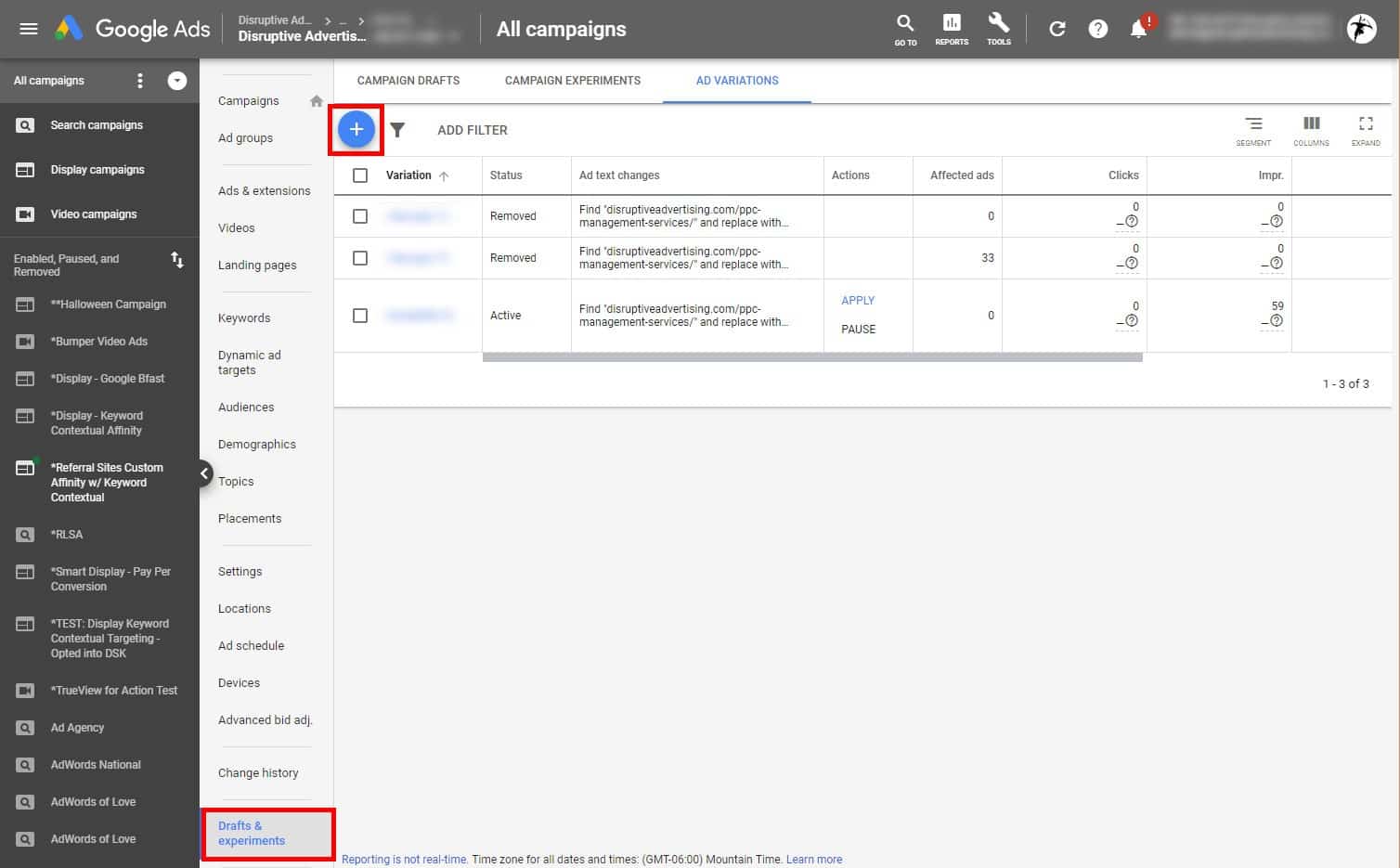
From there, all you have to do is choose which campaigns you want to test the variant in and build out your actual variant. You can tweak almost any part of your ad, so feel free to get creative and test all sorts of tweaks.
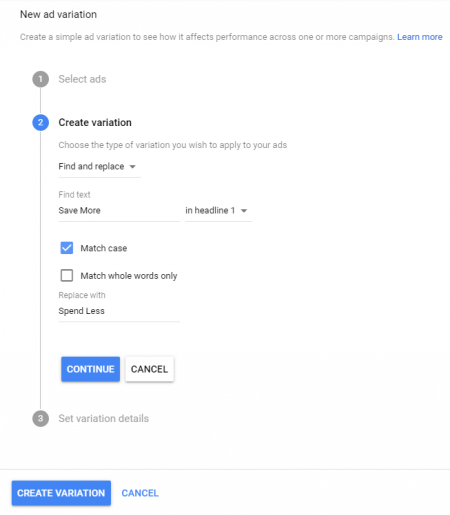
Ad Extensions
Ad extensions are another great way to test new content in your ads. To put it simply, ad extensions are additional information that you give Google when you create your ads. If Google decides that your information is relevant, they’ll show your extensions when someone sees your ad.

The good news is, there are a ton of different types of ad extensions and they all increase the real estate your ads take up. To make things even better, they add more information and/or clickable elements that can help convince people to click. This is a critical opportunity when you’re dealing with the restrictions of Google’s limited character counts.

Since it doesn’t cost anything to use ad extensions, really aren’t any drawbacks to them—provided that you have the time to create and optimize them. The good news is, thanks to all of that PPC automation you’re now using, you should have plenty of time to create ad extensions.
To get started, find “Ads and Extensions” and then click over to “Extensions.” You’ll see a list of the different types of extensions you can choose from, so click on the “Create” button to get started.
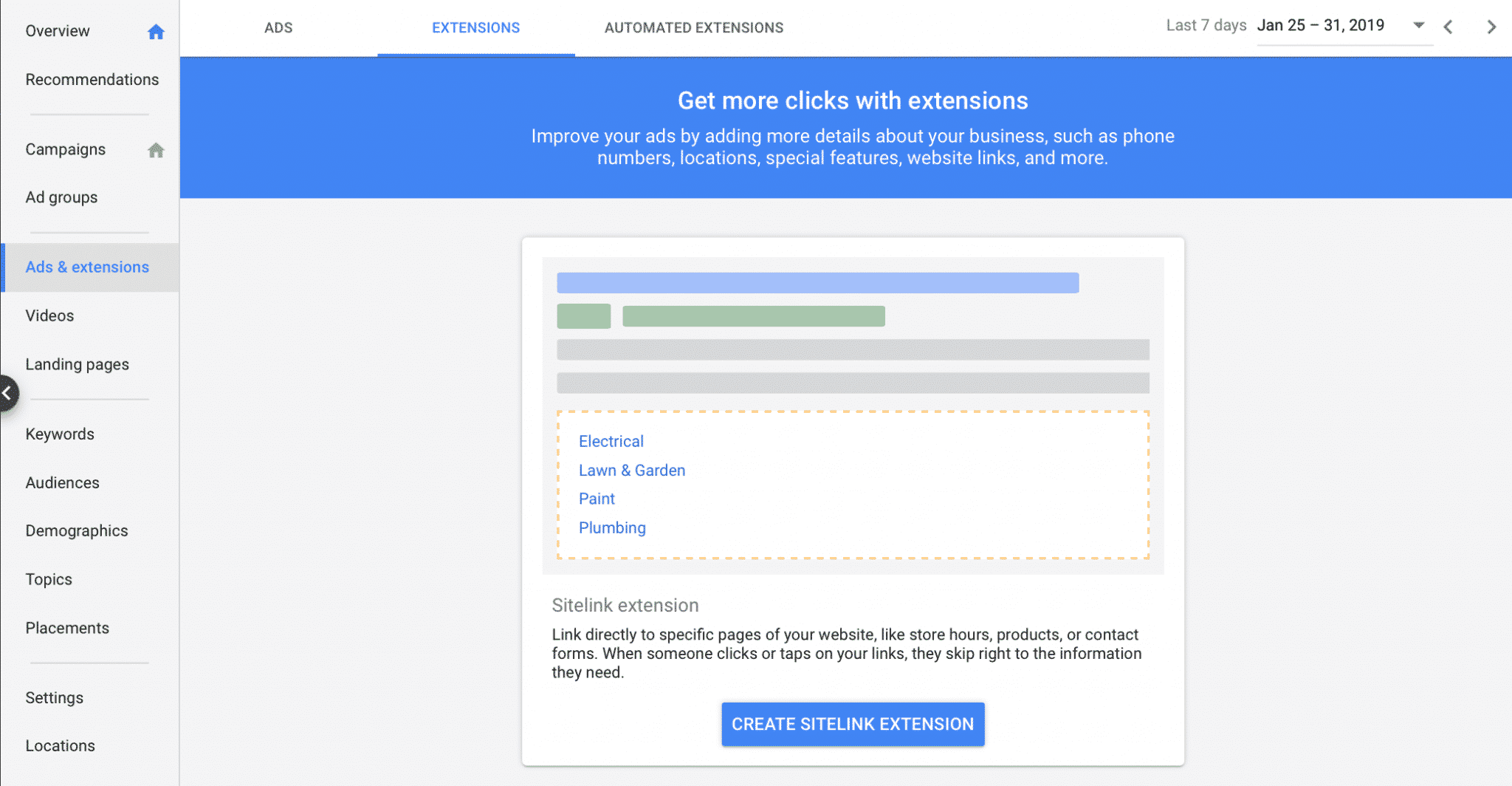
Each extension type will require you to enter in different information, but many will allow you to enter in descriptions and even URLs. Fill out each field that you can with crucial information—even if it’s optional—so that you can make the most out of the extension.
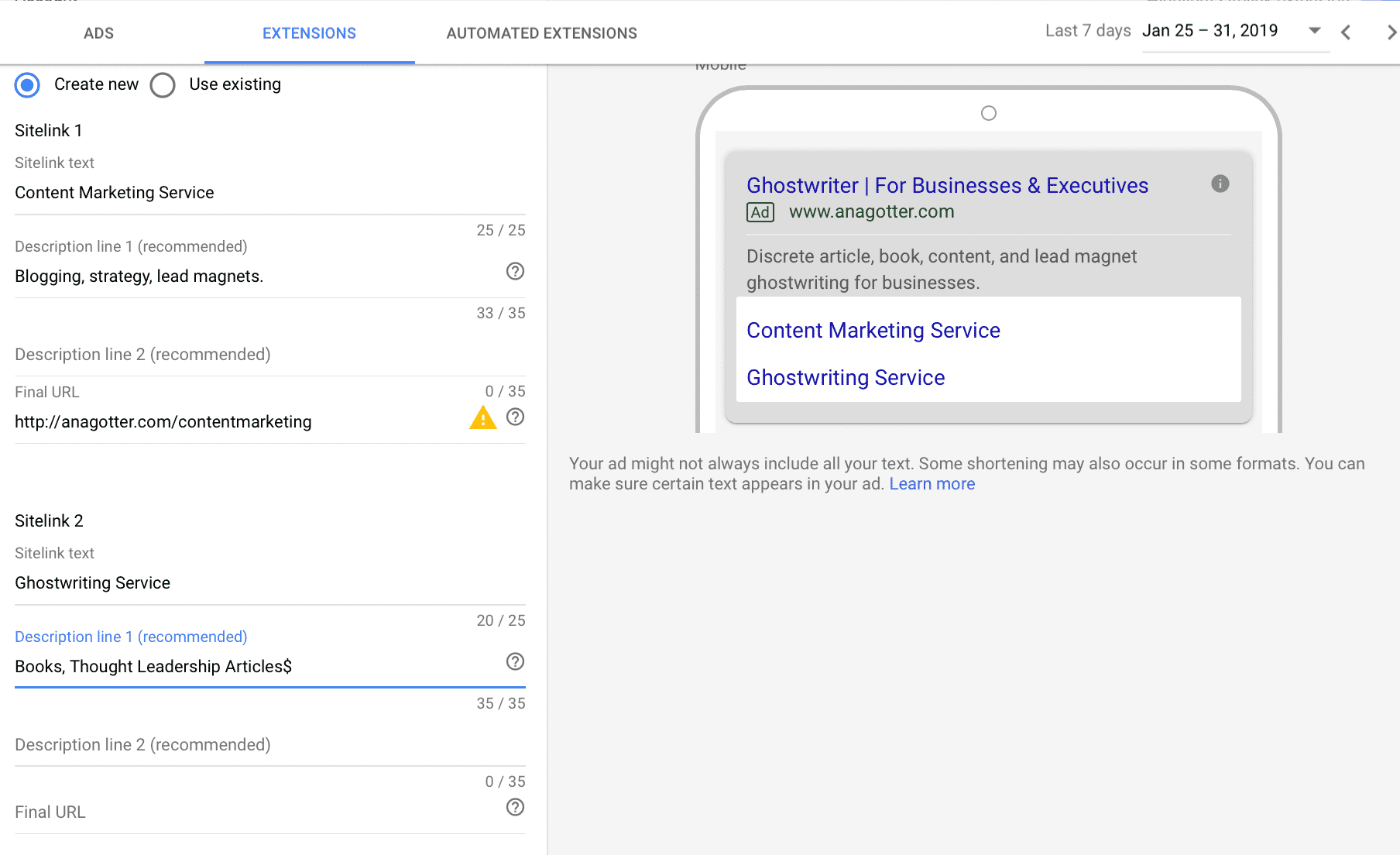
When creating different extensions, you’ll see the “Advanced Options” tab at the bottom of the page. These options let you customize who is seeing the extension and when. You can choose to enable mobile-only visibility (which may work for a call extension), or establish a dayparting schedule that affects only your extensions.
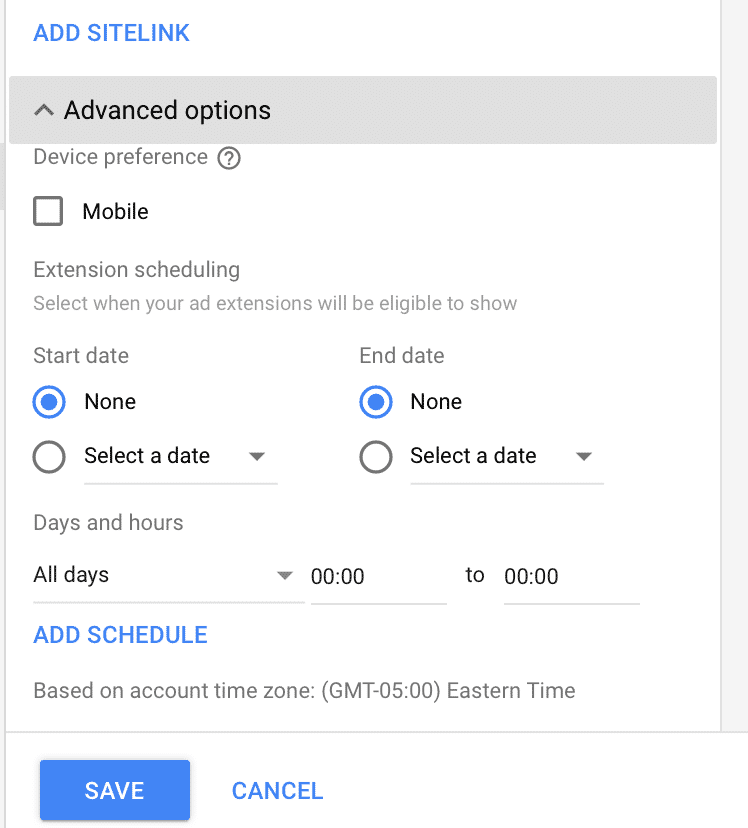
Dayparting, in particular, is a great option if you want to limit when certain actions or information are available (such as making call extensions only available during office hours or preventing sales from displaying after the sale period). Most extensions, however, won’t need the advanced options, so don’t feel like you have to use them unless it would actually benefit your ad campaign.
2. Take Advantage of New Features
Back when you spent most of your time down in the trenches of PPC management, it could be hard to stay on top of all the new features that Google is constantly releasing. But, now that a lot of the nitty-gritty can be managed by a machine, that gives you a lot more time to try out new things in your account.
Here are a few recent releases that you should consider exploring:
Responsive Search Ads
Google released this new ad format last year and it has a ton of potential for your account. Basically, you create a variety of different headlines and descriptions and then Google mixes and matches them to find the ideal combination.
Thanks to this new automation feature, it’s easier than ever to identify your best ads. All you have to do is get creative and Google’s machine learning algorithms will take care of the rest.
Headline 3 and Description 2
Expanded Text Ads have gotten even bigger, but you may not be taking advantage of the extra space. Well, there’s no better time than the present!
With an addition headline and description (along with an extra 10 characters for descriptions), you’ve got a lot more text to work with, so why not take advantage of PPC automation to get creative and make good on the full potential of your ads?
Discovery Ads and Gallery Ads
Google also has a lot of new ad types and options that are scheduled to drop later this year, so keep your eyes peeled for Discovery Ads and Gallery Ads. It’ll take some time to figure out how to make them work for your business, but if you’ve got your campaigns on autopilot, this could be a golden opportunity to take things to the next level.
Clean Up Your Account
It can be easy to get lost in the day-to-day of PPC management and forget to take a step back and look at the big picture. When this happens, a lot of little mistakes can slip into your account and compromise performance. This can be especially bad if you’re moving towards more automation, because the effectiveness of Google’s algorithms relies on the quality of data that you’re giving it.
Bad data = bad results, so as you automate more of your PPC account, it’s important to make sure that it’s in peak condition.
Tweaking, fixing and refining your account all take time, however. That’s why PPC automation can be so helpful when it comes to optimizing different aspects of your campaigns. Here are a few areas to review:
Wasted Spend
Often, what we think people are searching for when they see our ads isn’t what they’re actually typing in. Fortunately, there’s an easy way to see just how much money you’re wasting on the wrong searches.
The Search Terms report shows you exactly what people typed into the search engine that led to them seeing your ad, along with how many clicks, conversions, and impressions each of your search terms got.
An effective campaign will show your ads when people search for something related to your product or service. Since they’re looking for what you have to offer when they see your ad, they’ll click your ad and end up on a smooth landing page that leads them to convert.
To see how much money your account is wasting on search terms that don’t convert, simply create a filter for “Conversions < 1,” as follows:

Scroll down to the bottom of your table and divide the cost in your “Total – all filtered search terms” row by your total cost and multiply by 100% to get the percentage of your ad spend that you are wasting on the wrong search terms.
Note, this analysis works best if you are looking at your last 2-3 months of data. That way, you get a “big picture” view of your account performance with meaningful data you can actually use.
If you’re anything like the average account in our audits, you’re wasting around 76% of your budget on searches that never convert. So, if you’re looking for a quick and easy way to improve account performance, there’s no better place to start than with your wasted ad spend!
Negative Keywords
Along the same lines, negative keywords can be one of the best ways to improve the performance of your ads. Negative keywords prevent you from showing up in irrelevant searches that the algorithm may have otherwise placed your ad in. They also help you avoid people who aren’t actually your target audience. I’m a content marketer, for example, but I wouldn’t want clients who search for “cheap content marketer” or “$5 blog posts,” because I don’t deliver either of those things.
By improving the relevance of your ad placements, you can improve your click-through rate and minimize ad spend that could be wasted on useless clicks. The better your keyword targeting, the less money you waste on the wrong clicks, so you literally can’t afford to let a bad interpretation of your keywords derail your campaign.
Again, the Search Terms report is a great place to start if you haven’t updated your negative keywords lists in a while. If you’re seeing a lot of the same sort of term in almost relevant searches, you’ve just identified a great negative keyword candidate.
Check Your Analytics Setup
A few years back, I audited hundreds of Google Ads accounts in the hopes of figuring out what makes Google Ads campaigns succeed or fail. One of the things that shocked me the most was just how few accounts were tracking conversions effectively.
Now, in my study, 57.7% of Google Ads accounts had some level of conversion tracking in place. That was a disheartening statistic, but things got worse when I looked at how many were actually tracking conversions effectively.
Of that 58% of accounts with conversion tracking, only half—well, technically 50.1%—are actually tracking anything meaningful.
The other half were technically tracking conversions, but their setup was so poor that they might as well not be tracking anything at all.
![]()
For example, in the plumbing/HVAC industry, phone calls are a primary source of leads. However, most plumbing/HVAC companies only track form submissions, which are few and far between—making them a terrible indicator of campaign effectiveness!
Plumbers aren’t the only ones with this problem, either. Many companies with millions of clicks had only a handful of conversions to their name.
Yes, they technically had conversion tracking in place, but it wasn’t doing them any good.
So, even if you think your conversion tracking is working well, you should double-check. Can you track every type of meaningful action that occurs after someone clicks on your site, including things like chats, calls or visits to important pages? If not, now’s as good a time as any to beef up your conversion tracking.
Remember, your PPC automation is only as good as the data you’re feeding it, so if you aren’t tracking the conversion actions that matter to your business, Google is going to optimize for things that you don’t want. There’s no better way to waste money than to tell a machine to focus on producing more of the wrong thing.
Conclusion
For some marketers, PPC automation might feel a little scary. It’s like watching your kids grow up and head out on your own. You don’t always know what that means for your future and that uncertainty can be scary.
That being said, PPC automation brings a ton of new opportunities to really make the most of your accounts. Generally speaking, PPC automation can do all of the time-consuming things that kept you from being truly effective—freeing you up to focus on the creative, important things that a computer can’t replicate.
The only people who should be stressed about PPC automation are the marketers who don’t know how to do anything besides crunch numbers. If you’re a good marketer who loves figuring out the best ways to reach your audience, PPC automation is liberating. It gives you the freedom to test more, try out new features and really optimize your account. What more could you ask for?
By the way, if you’d like help implementing new automation features or getting creative with your marketing strategy, let us know here or in the comments. We’d love to help!
How do you feel about PPC automation? Do you agree with our take? How are you changing your marketing approach in light of all the new automation features Google has been releasing lately? Leave your thoughts in the comments.





